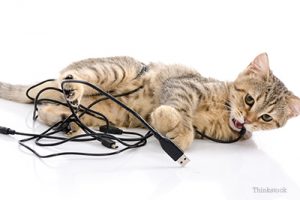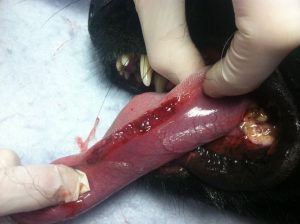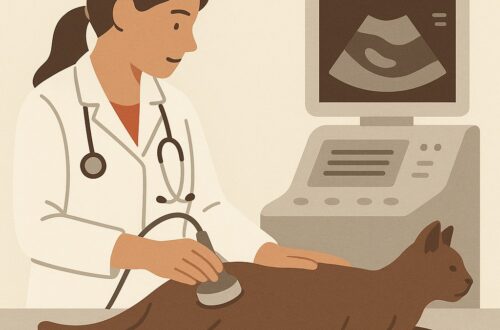Pediatric patients – humans, dogs, and cats, alike – can get into things they shouldn’t when left unattended and to their own devices. Cupboards full of potential toxins. Drawers full of sharp objects. One potential household hazard for our pets is electrical cords. Puppies and kittens love to chew on things, including cords plugged into electrical outlets. This week’s post contains information for pet parents to make them aware of this serious and potentially life-threatening problem. Happy reading!
Electrical Cord Injury – What is it?
Electricity is generated when electrons flow through a conductive material from high to low concentration. The type and extent of electrical injury is dependent on a myriad of factors, including voltage, strength of the current, resistance to flow, the duration of contact with the source, the pathway of flow, and the type of current. The spectrum of electrical injury is broad, ranging from minimal injury to death.

Household electricity provides 110V for standard use and 240V for high-powered appliances in the United States. Current, measured in amperes, is a measure of the amount of energy that flows through a body. Tissue heating secondary to a current may induce electrothermal burns. Spasms of skeletal muscle commonly occurs at 16-20 milliampere (mA), and a potentially lethal heart rhythm called ventricular fibrillation occurs at 50-100 mA.
Resistance is the impedance to electron flow across a gradient and is dependent on the electrolyte and water content of the body tissue through which electricity is being conducted. There is greater potential for transformation of electrical energy into thermal energy as the resistance of a tissue to current flow increases. For those interested in physics, Ohm’s law explains the relationship of voltage (V), current (I) and resistance (R): V = I x R.
There are two types of electrical currents: direct current (DC) and alternating current (AC). Alternating currents are the most common type in America with a standardized frequency of 60 Hertz and are considered three times more dangerous than direct currents. Muscle spasms commonly occurs at 40-110 Hertz.

Electrical Cord Injury – What does it look like?
Electrical cord injuries are relatively uncommon and are typically documented in dogs and cats less than six months of age. Clinical signs are typically referable to the mouth, skin, heart, and lungs. This type of injury commonly induces burns of tongue and the tissue at the corners of the mouth (called the commissures). Burns may be superficial, partial thickness, or full thickness.


Electric current also damages the lungs and the heart. Injured pets readily develop non-cardiogenic pulmonary edema (NCPE), a unique form of “water on the lungs.” The NCPE is thought to be multifactorial in origin, secondary to both leaky blood vessels and increased pressure within pulmonary veins caused by intense activation of the fight-or-flight system. Clinical signs consistent with NCPE and heart damage include:
- Coughing
- Fast breathing rate
- Difficulty breathing
- Blue/grey/purple tongue and gums (called cyanosis)
- Abnormal heart rhythms
It’s important to note onset of clinical signs of respiratory compromise may be delayed, manifesting 12-36 hours after exposure to electrical current. Other non-specific clinical signs associated with electrical cord injury include reduced (or loss of) appetite, weight loss, depression, bad breath (called halitosis), difficulty chewing, and drooling. Sadly, sudden death a possible outcome of electrocution.
Electrical Cord Injury – How is it diagnosed?
If you witness your dog or cat chew on an electrical cord plugged into an outlet, first unplug the cord. Disconnecting the cord from the outlet is of paramount importance to avoid personal injury. Once unplugged, safely and efficiently transport your pet to the closest emergency veterinary facility.
A veterinarian will ask appropriate questions about your pet’s medical history and will perform a complete physical examination. Electrical cord injury should be strongly considered in pediatric patients presented for evaluation with appropriate clinical signs as described earlier. A veterinarian will recommend performing some non-invasive testing to evaluate major organ systems for damage induced by electric current – these tests include:
- Complete blood count (CBC) – to evaluate red blood cells, white blood cells, and platelets
- Serum biochemical profile – to evaluate liver and kidney function, as well measure important electrolytes like sodium and potassium
- Urinalysis – to help evaluate the health of the kidneys
- Electrocardiography (ECG or EKC) – to detect abnormal heart rhythms
- Chest radiographs (x-rays) – to identify lung changes consistent with non-cardiogenic pulmonary edema
- Pulse oximetry / arterial blood gas – to help assess a patient’s ability to oxygenate and ventilate
Other minimally invasive testing, including echocardiography (heart ultrasound) and measurement of cardiac biomarkers, may be recommended based on the severity of patient’s injuries.
Electrical Cord Injury – How it is treated?
Treatment for a patient with electrical cord injury depends on the severity of injuries. Some patients may only have superficial burns in the mouth. For such pets, use of a special mouthwash to provide pain relief and protect tissues may be all that’s needed. Understandably, exquisite pain management is essential to ensure affects pets are as comfortable as possible. Patients with more severe burns may require surgery to remove dying or dead tissue from the mouth, and they typically require a temporary supplemental feeding tube to provide nutrients.
Patients with lung and heart damage need supplemental oxygen. They also need medication to help rid the lungs of the extra water contained therein (i.e.: furosemide / Lasix®) and to control any abnormal heart rhythms. Severely affected patients may need help breathing, requiring the use of a mechanical ventilator. Such pets are best served with treatment under the direction of a board-certified veterinary emergency and critical care specialist.
The take-away message about electric cord injury in dogs & cats…
Electrical cord injury is an uncommon but potentially life-threatening injury most commonly seen in pediatric patients. Ulcers and burns in the mouth, as well as damage to the heart and lungs, are classic lesions caused by electrical current. Prompt identification and timely intervention are key for maximizing the likelihood of a positive outcome.
To find a board-certified veterinary emergency and critical care specialist, please visit the American College of Veterinary Emergency and Critical Care.
Wishing you wet-nosed kisses,
CriticalCareDVM





